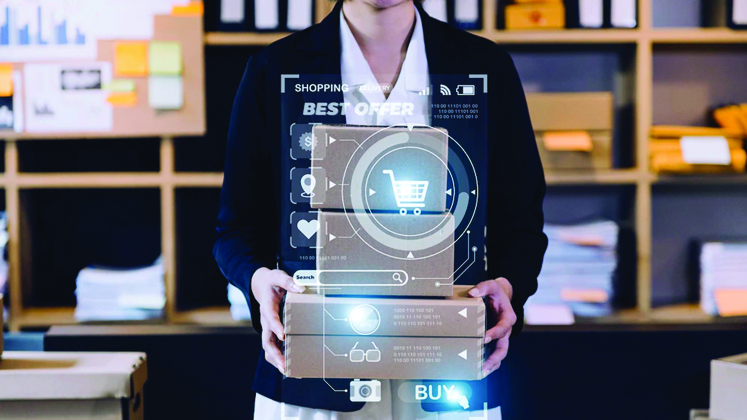 Five years ago, online shopping was tedious and required hours of browsing. Even websites were less responsive, offered limited user experience and were a total chaos in terms of product search and returns. As per the reports of Littledata in 2022, nearly 49 out of 50 customers who visited fashion e-commerce websites did not make a purchase on their first visit. The current worldwide conversion rate in apparel e-commerce market is only 1.8 per cent and thus retailers are taking the help of AI to improve online customer experience, increase checkout conversion and engage visitors. The AI integration will help to increase the rate of conversion which is expected to rise to 3-4 per cent and beyond as per reports.
Five years ago, online shopping was tedious and required hours of browsing. Even websites were less responsive, offered limited user experience and were a total chaos in terms of product search and returns. As per the reports of Littledata in 2022, nearly 49 out of 50 customers who visited fashion e-commerce websites did not make a purchase on their first visit. The current worldwide conversion rate in apparel e-commerce market is only 1.8 per cent and thus retailers are taking the help of AI to improve online customer experience, increase checkout conversion and engage visitors. The AI integration will help to increase the rate of conversion which is expected to rise to 3-4 per cent and beyond as per reports.
There is currently a conversion rate of just 1.8 per cent across the apparel e-commerce market. And for those in the bottom 20 per cent, the rate is three times lower- Littledata
The advancement of technology is improving the situation drastically. AI and machine learning have collaborated to make consumer shopping extremely interesting and easily provide more personalised recommendations, enabling retailers to better anticipate customer needs, assist in automating the entire shopping process. Additionally, they create interactive communication channels such as chatbots, proving that AI implementation in e-commerce is a game changer.
Moreover, retailers are adopting smart solutions to keep up with the rapid-fire demands of customers, who expect to find the desired product they want at the right price, in the right size, colour, style and material, all in the shortest time.
According to a market study report, the market for AI in retail would grow at a CAGR of 35%. The market size is anticipated to increase from US $ 1.80 billion in 2020 to US $ 14.71 billion in 2027.
-
Searching for the desired product has become more specific
Conventional methods of searching for a product on the e-commerce website rarely gave accurate results and the customers lost time in browsing the desired products. For example, a keyword of ‘Black T-shirt’ used to give results having a mix assortment of T-shirts, denim, dresses, hence there was a need to have more specific results. To overcome this problem, automated fashion tagging solution was adopted.
Automated fashion product tagging is the process of analysing and labelling a product image in an e-commerce catalogue by automatically identifying visual attributes. For example, if a product catalogue contains an image of a black sheer dress, image recognition and Machine Learning (ML) technology can ‘tag’ it as ‘knee-length, full sleeve, black sheer dress’
AI has made online search more ‘smart’ with ‘visual search’ gaining traction among retailers. Now, AI-powered search engines are in the driver’s seat, with an edge in understanding the intent behind searches and returning more relevant results. Whether it’s a specific product or information about a product, this is helping shoppers locate what they need faster and more efficiently online.
This is extremely important, as 60 per cent of online sales comes from the search field. An intelligent search uses artificial intelligence and has high speed, colour search 100 per cent automated; behavioural search customised for each customer; voice searched image.
Additionally, Neuro-Linguistic Programming (NLP) is also being used to improve search engines because it studies the relationships between how people think (Neuro), language pattern they use (Linguistic), and actions (Programming), as well as the positive and negative effects of these interactions.
Reliance-owned start-up Fynd, has added a Chrome extension Fynd Now, where customers can upload an image from their phone’s gallery to link a visual from the web and discover it or similar products on the platform. The feature uses AI to identify the product in the image/video and recommends a similar product from Fynd.
As a result, some retailers are employing the NLP approach to search, which is based on AI allowing computer programmes to understand human speech, allowing customers to conduct searches in a similar manner like one does in the physical store. Myntra, Ajio, Nordstrom, Urban Outfitters and many others are just some of the retailers that have found success with visual search.
Solutions like Clarifai, Google cloud vision API, InfiViz etc., are examples of deep learning image recognition system which actually help to identity the products being uploaded for search.
-
24/7 available e-commerce chatbots assist in customer service
Traditional methods of e-commerce have never made use of chatbots as value was unknown but now the chatbots are considered the newer form of AI that allow customers to communicate with businesses via text or voice messages. Chatbots’ enhance linguistic capabilities and contextual responses for the consumer and therefore are the result of a convergence of AI, NLP and machine learning algorithms.
Customers get information about their orders, products and the company’s return policy and recommendations in a matter of seconds by connecting with a chatbot rather than waiting for a human customer service representative to respond. Companies in the retail sector are spending money on chatbot technology for their online store.
The potential for chatbots to bridge the gap between consumers and businesses is promising, and it bodes well for the future of the industry. When it comes to customer service, chatbots are used as live agents and are even more convenient for the users, thanks to features like round-the-clock availability.
For example, Nykaa worked with Verloop.io to improve customer engagement by solving problems over chat. Nykaa used bot-qualified questions from Verloop.io to handle repetitive requests like cancellations, returns, shipping inquiries, replacements, refunds and payment issues. Verloop.io’s broad integration options helped Nykaa switch software systems smoothly (including Ticketing Software, CRM, among others). Verloop’s automation and NLU modules used both classical machine learning and deep learning.
Solutions such as verloop.io, ChatGen.ai, Tidio, Snatchbot etc., integrate with the e-commerce platform to provide the most effective chatbot assistants to help with conversion rates.
-
Predictive Analytics and personalisation create the best basket of assortments
In the past, stores only stocked products chosen by senior management on the basis of sales projections or guesswork. However, now, predictions of what will sell and where it will sell best are being made much more quickly, thanks to AI implementation.
AI’s ability to personalise e-commerce services is one way it aids today’s online retailers in providing an optimal customer experience and ensuring customer loyalty.
Based on past purchases and interactions, AI makes product recommendations. Retailers collect a ton of information whenever a customer visits a new page or clicks a link; using this information, they rank products and make suggestions in order to reduce dwell time.
For instance, if one has looked for green denim on Amazon before, the site will most likely recommend other colours in denim the next time one visits.
This is because the megastore recognises what customers are looking for in denims at the moment and accordingly tailors its recommendations for them. This not only makes customers happier but also aids in revenue generation for companies.
Artificial intelligence algorithms examine a shopper’s actions and acquisitions to tailor recommendations and produce a one-of-a-kind buying experience. Additionally, they sift through mountains of data to make accurate guesses about consumer behaviour, set target audience and offer discounts and promotions based on them.
For example, Flipkart partnered with Microsoft and adopted Microsoft Azure to process the data and to provide the personalisation tips. Additionally brands like TATA cliq, Nicobar, Milaner, Amazon, leverage the MAD’s Vue.ai’s vertically integrated intelligence stack for retailers and help customers to have recommendations aligned with the search.
E-commerce websites use AI-powered recommendation engines such as Bloomreach, Clerk.io, Optinmonster to analyse a user’s search history, browsing habits and purchases to make recommendations based on a user’s specific interests. This not only aids shoppers in locating their desired items but also makes it easier to close the purchases instead of scrolling what could match the item purchased.
-
Competitive pricing leverages better deals and faster closures
Price point is one of the most important factors when it comes to capturing the attention of customers. A dynamic pricing AI can alter the price of an item to increase the likelihood of a conversion for a specific customer by analysing the products that a user clicks, adds to their cart and purchases. First-time buyers can be enticed with lower prices, and price-sensitive customers can be provided with slightly reduced rates. In other words, AI capable of dynamic pricing can provide personalised pricing and customer usually bags some great deals.
McKinsey claims that leveraging dynamic pricing models has helped their customers increase their sales up to 5%.
Due to the proper in-depth analysis of competitors’ prices, retailers are able to make more justifiable decisions regarding how to adjust prices for their e-commerce stores and how to determine the optimal prices for their products. Therefore the customers have an advantage of acquiring the product first.
Brands like eBay, Amazon and Myntra leverage different types of dynamic pricing for better conversions.
Solution providers such as Intelligencenode, Aruhat, Pricemanager etc., help in price monitoring regulating the price as per the real-time market trends.
Picture this!
For instance, X wants to purchase a black outfit precisely balloon sleeve top with a peplum skirt in sheer fabric .X needs to login on the website, and then they get the desired result in a matter of seconds either by uploading a similar image or by searching with the keywords. This eliminates the need to engage in an endless amount of browsing activity. X is also capable of filtering the price range and comparing the prices of products on various websites, which opens up a wealth of opportunities for making a speedy purchase either on the same website or by switching to a different one. Additionally, the website offers a virtual try-on service so that X easily sees how the garment will look on her before purchasing it. While her virtual look is being prepared, she is presented with additional styles that may be appropriate for her body type. As a result, she decides to purchase an additional pair of pants based on the recommendations, also taking a look at other personalised options for bundle accessories and footwear creating full look. X has been served few discounts and coupons by the time the customer moves towards the cart. X interacts with the chatbots to learn more about the sales and discounts, and receives a very human interaction reply from the other side, which leads to instant gratification. This is then followed by a seamless checkout, and the details are provided to X via her Whatsapp, thereby keeping her updated with the real-time journey. All this is also being leveraged by unified commerce providing holistic shopping scenario.
AI may sound like something out of a science fiction novel, but e-commerce that is enabled with technological solutions makes things easier for customers, improves their overall experience, increases conversion rates and contributes to how businesses are run. The very best shopping experience is only attainable if retailers of any size are willing to integrate the necessary components into the system. This is true irrespective of whether the retailers are large or small, AI implementations may initially be viewed as an investment, but if used effectively, they will generate twice as much revenue as before.











